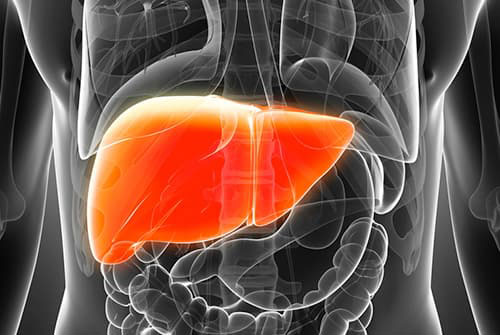Public awareness about liver diseases is increasing. But the perception of alcohol being the most important cause needs to be updated as the incidence of liver failure and cancer due to non-alcoholic fatty liver is increasing. The trend is similar across the world.
Epidemiology:
At present, NASH is the third most common cause of chronic liver disease of viral hepatitis and alcoholism, but it is predicted to become the most common cause in the next decade. In India, the prevalence of NASH is 9-32% of the population and higher in people with metabolic syndrome as suggested in epidemiological studies1. In a recent study done on 1388 healthy blood donors, the incidence of fatty liver was seen in 55%. So, the scourge is coming and we need to create awareness of the disease, its prevention and treatment.

Metabolic Syndrome:
Several studies and research have now confirmed that Non-Alcoholic Fatty Liver Disease (NAFLD) exists as a part of the metabolic syndrome. The liver component exists apart from diabetes, cardiovascular diseases, osteoporosis and chronic kidney disease even has suggested the nomenclature to be changed as Metabolic dysfunction Associated Fatty Liver Disease (MAFLD).
Risk Factors:
Subjects with NAFLD, when compared to those without, had significantly higher age, BMI, waist circumference, blood pressure, total cholesterol and triglycerides, low‐density lipoprotein and fasting plasma glucose. Hence, these factors may be considered for screening to diagnose NAFLD. The metabolic syndrome prevalence was 41% in NAFLD patients whereas the same in patients with NASH was found to be 71%. The prevalence of hyperlipidemia/dyslipidemia was observed to be on the higher side at 69% in patients with NAFLD and 72% in patients with NASH. In view of high prevalence of metabolic syndrome and dyslipidemia in patients of NAFLD, these patients require aggressive treatment and risk stratification to control the risk of cardiovascular disease. Compared to the general population, a higher prevalence of obesity (51% of individuals with NAFLD and 82% of NASH patients) and diabetes mellitus (23% of NAFLD patients and 47% of NASH patients) was observed3.
Pathogenesis:
The pathogenesis of NASH has been explained by a ‘multiple-hit’ hypothesis wherein the first hit is with insulin resistance and leading to imbalance between cytokines (tumor necrosis factor alpha), adipokines and adiponectin (those secreted by adipose tissue) and proinsulin. This results in increased lipogenesis in liver leading to hepatic fatty acid infiltration. In this model, the first hit is insulin resistance and its associated metabolic disturbance, whereas reactive oxygen species-induced oxidative damage, deregulation of hepatocyte apoptosis and multiple adipokines are multiple hits resulting in NASH in pre-existing steatosis. Recent studies prove, genetic polymorphisms that are involved in regulation of hepatocyte lipid content have been strongly associated with NASH. The role of environmental factors leading to change in gut microbiota leading to dyslipidemia and metabolic syndrome is also being studied.
Diagnosis:
It is generally asymptomatic and the only clinical sign maybe hepatomegaly. Most people present with mild elevation (‹3times) in SGOT, SGPT with the raise in SGPT slightly higher than the former. USG screening detects diffuse increased echogenicity with homogenous architecture – “bright liver”. Grading of fatty liver is based on the enhancement of portal vein walls and diaphragm, estimating mild (10-30%), moderate (30-50%) and severe (›50%) steatosis. Further evaluation with USG elastography, fibroscan or MRI maybe done after consultation with a liver specialist. Liver biopsy gives a definitive diagnosis but is rarely used because it is invasive and less acceptable in asymptomatic patients.
Management: The treatments studied include lifestyle modification, pharmacological agents and metabolic surgery. The treatment should target the three major processes involved in pathogenesis – insulin resistance, inflammation and fibrosis.
- Lifestyle Modification – Working groups across the world have recommended low-calorie diet and intense physical activity to be effective in reversing the steatohepatitis, reducing the fibrosis and fat content in the liver in NASH patients.
- Medical Therapy – Vitamin E & pioglitazone are the only recommended agents in treating NASH though several other drugs including UDCA, metformins and fibrates have been tried. Statins have some role in patients with dyslipidemia and raised liver enzymes.
- Surgery – Bariatric surgery has been a radical treatment advised in severely obese and proven to be effective in the reversal of NASH. But the role in other patients still needs more evidence.
The safety and efficacy of several other newer agents like obeticholic acid, liraglutide, cenicriviroc, elafibranor and aramchol are being studied under several controlled trials and yet to be recommended in guidelines.
The need for creating awareness of this rising scourge is huge and important as the predicted morbidity and mortality related to this syndrome is preventable with appropriate intervention. The responsibility lies with practitioners across all the specialities as it is a multi-system disorder being diagnosed with multiple co-existing problems.

Dr K. Elan Kumaran
Senior Consultant & Head, Liver Diseases & Transplantation Centre,
Kauvery Hospital, Chennai
References
- Nonalcoholic fatty liver disease in India – A lot done, yet more required! Duseja A. Indian J Gastroenterol 2010;29:217-25.
- High prevalence of non‐alcoholic fatty liver disease among healthy male blood donors of urban India -Ajay Duseja, ShaneezNajmy, SuchetSachdev , Arnab Pal, JGHF, Jan 2019
- Chalasani N, Younossi Z, Lavine JE, Diehl AM, Brunt EM, Cusi K, et al. The diagnosis and management of non-alcoholic fatty liver disease: Practice Guideline by the American Association for the Study of Liver Diseases, American College of Gastroenterology and the American Gastroenterological Association. Hepatology 2012;55:2005-23
- Cytokines in alcoholic and non-alcoholic steatohepatitis -Tilg H, Diehl AM. N Engl J Med 2000;343:1467-76.

